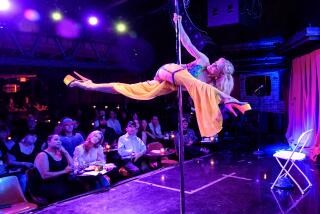Polo Crowd Not Necessarily the Elite : U.S. Open: Those who see Hanalei Bay win the championship include the rich and famous, but also the average sports fan.
- Share via
INDIO — If you saw the scene from “Pretty Woman” in which Richard Gere takes Julia Roberts to a polo match, and you wondered if that’s what polo games are really like--white gloves and fancy ties--the answer is yes.
And no.
It is a game in which the pretentious can be even more so, and the unpretentious can be unobtrusive. There were several of each Sunday at the Eldorado Polo Club in Indio watching some of the best polo players in the nation play for the U.S. Open Polo Championship, one of the most prestigious tournaments in the world.
And yes, the crowd was asked to stomp divots at halftime, during which a tune by Roy Orbison was played. And there was the perfunctory: women in floppy hats and men in starched white shirts sipping champagne under white tents in 80-degree temperatures.
Watching it all from there was actor William Devane and soap-opera star Steve Bond.
But there were also those in casual clothes--baseball caps and T-shirts that advertised tequila. There were those picnicking in the general admission section on the other side of the field, where hamburgers were sold and where beach towels replaced white tablecloths.
Watching it all from there was retired senior citizen Penny Ortisi and her daughter, Pamela, who each paid $10 for admission. Usually, it costs $7. For regular tournament games, clubhouse admission with waitress service is $25.
So maybe this reputation for wealth and exclusivity is a product of English polo?
“No, it’s the same type of crowd there,” retired polo player Carlton Beal says. “Only in England, you play in front of the Queen.”
Here, on a bright desert day, the Gracida brothers, Carlos and Memo, played before 1,500 and led Hanalei Bay to the championship, beating Fish Creek, 13-6.
Hanalei Bay dominated from the beginning, leading, 7-2, at halftime, with Carlos scoring five of those goals on breakaways. And yes, the crowd does cheer. Sometimes it even hoots.
Carlos Gracida was the high scorer with eight goals, followed by Julio Arellano of Palm Beach, Fla., with three and Memo Gracida with two. The Gracidas also are from Palm Beach.
The Gracida brothers are 10-goal players, the highest ranking in polo. There are only six 10-goalers in the United States. Fish Creek’s Owen Rinehart of Charlottesville, Va., is a 10-goaler, but scored only one on Sunday. Julio Zavaleta of Argentina scored the most goals for Fish Creek, four.
It was a big victory for Ron Bonaguidi, 44, who owns a financial investment firm in Rancho Santa Fe. Bonaguidi put the team together, played on it and financed it, the customary procedure for a sponsor. He spent about $400,000 for his victory.
“I’m going to savor this for a long time,” said Bonaguidi, not talking about the champagne he sprayed on himself and his teammates after he received the 88-year old Open trophy.
“But the myth that polo is a rich-man’s sport is wrong. Polo is a game for everyone. There are teams, even in this tournament, that play with a more reasonable budget.”
The sour economy did have an effect on the Open. Usually there are eight teams; this time, only five could afford to play at this level.
“It’s not an inner-city game, but it’s just not for the Rockefellers,” said Ami Shinitzky, the editor of Polo Magazine.
“They have six-pack polo where the blue-collar crowd plays. I went to Inner Mongolia and they were playing there. And I said to them, ‘How do you feel about this being a capitalistic game?’ And they said, ‘What are you talking about?’
“A horseman is a horseman. You play what there is to play.”
For polo, you need a field measuring 300 yards by 150 yards. It’s an intense sport, where specially bred horses run after a ball that can travel at speeds from 90 to 120 m.p.h., is about 3 1/2 inches in diameter and weighs about 3 1/2 ounces. There are six periods, each 7 1/2 minutes long. Horses are changed after each period, called a chukker.
Professional 10-goal players are paid about $10,000 a month, or $1,000 per goal rating.
“But you don’t play every month,” said Joe Barry, 49, whose team, BTA, was eliminated in the Open semifinals.
Barry’s family is third-generation polo, a common situation in the polo community. His father, Harold, is in the Hall of Fame and his son, Joe Wayne, 16, is on the rise.
Barry has traveled all over the world playing polo, but he says the best crowds he ever played for were in Milwaukee in the 1970s, at Good Hope Farms. He says fans would start arriving about 10 a.m. for a 3 p.m. game, would set up their barbecues and start cooking bratwurst.
“The matches would draw about 10,000 people, and you would love this crowd,” Barry said. “They would play Frisbee and soccer on the field before the game. A real family thing. Then they would clear the field and pick the teams they wanted to root for. They would raise hell out there.”
More to Read
Go beyond the scoreboard
Get the latest on L.A.'s teams in the daily Sports Report newsletter.
You may occasionally receive promotional content from the Los Angeles Times.










